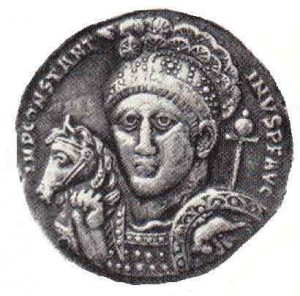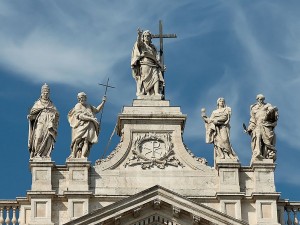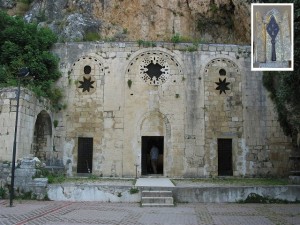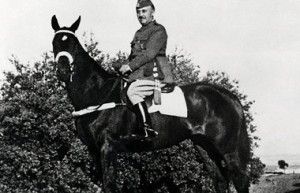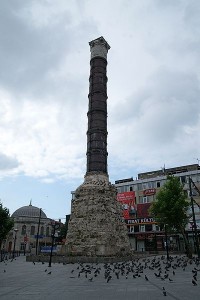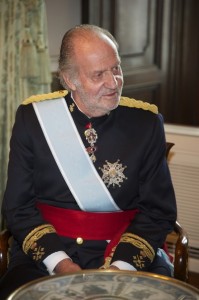Christian Revolution Under Constantine: 1700th Anniversary Series, Part 4
In late Spring, AD 312, Constantine’s victories at Susa and at Turin in northwestern Italy liberated Roman domains as far east as Milan, much to the joy of Christians and also of many pagans alienated from the co-Emperor, Maxentius. Misrule by Maxentius in the Roman diocese of Italia had greatly undermined his standing in public opinion.
Still to come was the battle of Verona in the late summer of 312, followed by the decisive battle of the Mulvian Bridge outside Rome on October 28th. Following this series of military coups, revolutionary changes soon ensued. Of God’s providence for Constantine and his contemporaries, the Magnificat tells prophetically of the persecuted Christians whom God would exalt:
He has shown might in his arm. He has scattered the proud in the conceit of their hearts. He has put down the mighty from their thrones and has exalted the humble.[1]
During his single term in Congress, Abraham Lincoln said: “It is a quality of revolutions not to go by old lines, or old laws; but to break up both, and make new ones.”[2] When writing history, one is tempted to tidy up such revolutionary transformations by downplaying the upheaval that spawned them and the mystery that surrounds them. Such scholarly tidiness is like courtroom decorum where procedural regularity takes priority over a wisely rendered verdict; or like a priori disdain for articles in Wikipedia because the site’s populist character is at variance with the polished peer review process proceeding from the towers of academia.
Revolutions are inherently chaotic; they may indeed be responses to intense turmoil in society beforehand. So too with the Christian revolution under Constantine. The chaotic and tumultuous nature of Roman society during the Great Persecution can hardly be overstated, especially for the millions of citizens who were Christian.
Even during respites from persecution, the Roman culture and economy, with its gladiatorial games and wars to gather in harvests of new slaves, had become a parody of civilization. The rule of law was a masquerade. In reality, it had long been a regime of oppression imposed by one warlord after another who styled himself Caesar or Augustus or Emperor.
Adding new horrors to the general malaise, Diocletian and his immediate successors made a concerted attempt to impose imperial uniformity in matters of religion. Their means, from 303 to 312, was a campaign of extermination against dissenting Christians. It was deemed disloyal to the state that a citizen should undermine the political order by refusing to worship the divinity of the genius of the Roman Emperor. Such defiance was seen as no less seditious than during the heyday of ancient Egypt; a resident remained standing at his peril if the Pharaoh processed by. As in pagan Rome, one’s choice was either death or (as in the film, The Egyptian) “on your faces before the living god.”
An area of mystery that historians are hard pressed to penetrate is the skyborn Chi Rho vision. It is commemorated to this day on Roman Catholic altars, and is displayed most prominently on top of the Pope’s official cathedral in Rome, the archbasilica of St. John Lateran. Though we rightly reverence the revelation in the sky witnessed by Constantine and his troops, can we accept the notion that the Christian revolution appeared with equal suddenness — that such a political innovation issued forth, as it were, out of the blue?
An associated mystery is whether the vision of 312, however impressive, transfigured Constantine overnight. It is not impossible — notwithstanding the certainty to the contrary of some eminent historians — that for months or years prior to the Chi Rho vision, Constantine was spiritually primed for his conversion, even if he was not already a Christian as T.G. Elliott postulates.[3]
Of this we can be sure: Almighty God was manifestly providential in giving Constantine and his troops such an inspiring vision; it was timely, too, considering the advantages enjoyed by the enemy and their demoralizing effects upon Constantine’s army. Maxentius’ edge included his more numerous legions and the near impregnable protection of Rome’s Aurelian wall, whose height he had recently doubled.[4]
Another question is whether we are now celebrating the 17th centennial of what G.K. Chesterton called “the rush and romance of a crusade.” Or was it yet another secular civil war which in this case — thanks to divine Providence — worked to mankind’s benefit?
Certainly Constantine’s military expedition twelve years later, June to mid-September, 324, was a spiritual crusade, and not just a war of conquest. Licinius ruled the eastern half of the Empire and had returned to worshiping the Olympian gods. Alas also, he had resumed the persecution of Christians. Constantine was determined to liberate his confreres in the Faith. Therefore, his campaign of 324 can, as Professor Odahl puts it, “rightfully be called a ‘religious crusade’ or a ‘holy war’ between classical paganism and the Christian religion.”[5]
But the attack on Maxentius in 312 is not so clear cut. Putting the Chi Rho symbol on your soldiers’ shields does not a crusade make. Two factors to consider are Constantine’s political intent at the time; and to a lesser extent — in defining a crusade — the spiritual disposition of the leader’s heart.[6] A third factor, and a confusing one, is the religious character of Constantine’s foe, Maxentius, who switched directions several times in his policy on dealing with Christians.[7]
However that may be, Constantine did launch three civil wars. In the last one with Licinius, he conquered the entire Empire, setting the stage for a Christian revolution that qualifies as the most important political revolution of antiquity — indeed of all time. Thus, the famous First Crusade of 1098, which captured Jerusalem from the Muslims and established four Christian kingdoms in the Holy Land, should be re-numbered by historians, and be relegated to the more accurate chronological appellation, “Second Crusade.” (Or “Third Crusade” depending on how we categorize Charlemagne’s Saxon campaigns of 772-80).
Constantine was in fact history’s first military crusader, and his army the first to take the cross. He and his legions drew inspiration from the Chi Rho vision much as the crusade of the 11th century was stirred to renewed vigor by the prophetic vision of Peter Bartholomew. This mystic soldier’s vision, leading to the unearthing of the Holy Lance beneath the floor of St. Peter’s Church in Antioch, provided the boost in morale needed for the Crusaders during their greatest moment of peril. In terms of its effect on the campaign, the comparison with Constantine’s vision is striking, in that prior to the Chi Rho apparition Constantine’s officers had been verging on defeatism.[8]
By way of contrast, however, Constantine’s crusade was more chivalrous in medieval chivalry’s charitable sense than was the storming of Jerusalem in 1099, with the subsequent massacre. Neither in his war with Maxentius, or in his two wars with Licinius, did Constantine sack cities or his troops inflict massacres upon civilians. In terms of higher standards of conduct, i.e. deportment as distinguished from chronology, Constantine’s soldiers rate first among history’s crusaders.
How might the Christian Revolution of the 4th century pertain to our own day? For citizens of Spain the event is current today, in that the memory of the Spanish Civil War is still very much alive. If the first crusade occurred in Constantine’s day, then The Last Crusade took place during the lifetime of many Spaniards still living. Consider, for example, the historic displays in Toledo’s Alcazar Fortress, where Gen. Francisco Franco is lauded, much as was Constantine, for rescuing Christianity. As Constantine overthrew the governments of Maxentius and then Licinius, so Franco marched against the persecuting, anti-Christian government of the Second Spanish Republic (1931-1939).
Just as Diocletian and Galerius had made a “quite serious attempt to extirpate Christianity” in order to restore religious unity in the Empire, i.e. to return society to the traditional pantheon of pagan gods; so in Spain the government of the Second Republic came to embrace the policy of extermination. Virtually the same motive applied in the 20th century as in the 4th: Silence Christianity by political force, so that pagans could more readily push their agenda, and might encounter no disconcerting contradictions.
And the remedy was somewhat similar. Against both persecutions, the Spanish and the Roman, a considerable interval transpired before the interposition of Divine Providence became manifest. In each case a man on horseback arose who loved Catholicism. But Constantine’s reign was by far the most blessed, enduring as it did for more than a thousand years (until the fall of Constantinople to the Turks in 1453). Whereas Franco’s new order flourished only during his lifetime.
As Hugh Thomas, an eminent secular historian of the Spanish Civil War puts it, Franco’s policy of limpieza, the ‘cleaning up’ of Spain from evil, worked poorly in the long run. Franco did end the bloody persecution; he did stop the Republic’s murdering of nuns and priests by the thousands, including 13 bishops. Moreover he was a practicing Roman Catholic; accordingly his dictatorship was less brutal than the pagan regime in Nazi Germany or Mussolini’s Fascists in Italy.
But Marxists, anarchists, and the like “have long since returned to Spain.”[9] Moreover, I might add, politicians have come back into power who have worked assiduously, and with no small success, to impose pagan policies on Spanish society. All within the span of one person’s lifetime.
In contrast to Franco’s short-lived triumph, Constantine’s military victory was followed by a judicious balance between “driving the dragon from the administration of public affairs” while extending a limited tolerance to the defeated pagans.[10] The long-term result was a Christian revolution whose salutary effects we celebrate this year and next.
Given that the work of Constantine the Great stood the test of time, whereas the memory of the Caudillo soon became controversial in Spain; I think the revered statesman and general, George Washington, is more comparable. Like Constantine, Washington proved to be both a great military commander and an illustrious political leader. “First in war, first in peace, and first in the hearts of his countryman.” This panegyric might have been applied to Constantine as fittingly as to Washington.
Moreover, unlike General Washington, Franco was hardly a daring strategist; his plodding military campaigns look a lot like Ulysses S. Grant’s meat grinder strategy during the American Civil War. Grant was no Napoleon, and Franco was no Washington. In terms of results, Constantine exceeded them all. His campaigns are the picture of shrewdness and boldness, of just the proper balance between prudence and risk taking. He would exhibit daring, rapidity of movement, and personal courage. Constantine inspired men to emulate his own valor.
In statesmanship also, he exceeded Washington, in that Constantine was not just the “Father of his country,” but the father of western Christendom – defined as the political sphere leavened by the Gospel. His self-declared mission to Christianize Roman domains was far more zealous than Washington’s policy on religion; and the Christian revolution under Constantine spread to whole continents beyond the old imperial borders.
An example of his zealousness for Christianity took place during the dedication of Constantinople as Nova Roma,[11] the “new Rome,” on May 11, AD 330. In an elaborate liturgy, described by a pious Byzantine source, the capitol city was dedicated to the Immaculate Heart of the Blessed Virgin Mary. At the time the imperial domains consisted of twelve dioceses,[12] and therefore the Christianized Roman Empire can be said to have reflected Revelation 12:1:
a woman clothed with the sun, the moon under her feet,
and upon her head a crown of twelve stars.
Contemplate the above verse in the context of Constantine’s symbolic fulfillment of it: The unsurpassed might of imperial Rome now governed twelve dioceses, and their presiding capitol city was dedicated to our Lady.
Constantine’s capitol city conveyed yet another twelvefold symbol regarding his Christianizing mission, and his regime’s subordination to it. The Emperor erected a statue of himself (the 35 foot high support column still stands) which was prominently in view as ships approached the city.[13] At its base were placed twelve baskets representing the dozen baskets of leftovers from the miracle of the loaves & fishes. It is obvious that any scraps leftover are lower in importance than the main course, i.e. the feeding of the 5000. Thus did the Emperor’s spire in Constantinople put the entire political sphere into perspective – i.e. politics at its best is a bunch of scraps in comparison to the glories of the Good News.
By representing his office as subordinate to the Gospel, the higher good, Constantine was more akin to Washington than to Franco. During the swearing-in ceremony at his inauguration, Washington initiated the tradition whereby the President-elect places his left hand on the Bible and raises his right hand to swear the oath. And in many secular ways too Washington subordinated his Administration to the U.S. Constitution. Constantine could not, of course, have done likewise since written constitutions had not yet developed, nor acquired their status as supreme laws of the land.
Franco lived in 20th century Europe and had no such excuse. He chose to rule in the secular sphere with no real constitution from 1939 until 1967. His main provision for succession was the naming in 1969 of young Juan Carlos de Borbon as the heir to a reconstituted Spanish monarchy. Assuming the throne after Franco’s death in November, 1975, King Juan Carlos presided over a gradual paganization of the country. In 2005 he granted royal assent to same-sex-marriage, and in 2010 to the availability of abortion throughout Spain.
By contrast, Constantine made a concerted and largely successful effort to see that his successors were true to his vision, and above all to his mission of Christianizing the Empire.[14] In the long-run Franco failed in his mission to re-Christianize Spain; whereas Constantine succeeded on an enormous scale, both geographically and historically.
_____
Endnotes
[1] Luke 1:46-55 contains the text of the Magnificat, the Canticle of Mary.
[2] Abraham Lincoln, January 12, 1848; Speech on the Mexican-American War.
[3] T.G. Elliott, The Christianity of Constantine the Great (Scranton PA: The University of Scranton Press, 1996), p. 325: from 306-337 Constantine was a man with a Christianizing mission; p 331: the “critical experience of Constantine’s life was not the ‘miracle of 312,’ but the Great Persecution,” cf. p. 214.
[4] Charles M. Odahl, Constantine and the Christian Empire (New York: Routledge, 2nd ed., paperback, 2012), p. 87.
[5] Odahl, ibid., p. 177.
[6] Certainly Enrique Gorostieta’s purpose was to lead a crusade against the pagan government of Mexico. But the anti-clerical and Masonic state of his heart did not render the Cristero War any less of a crusade.
[7] Odahl, supra, p. 92.
[8] Maude Aline Huttmann, The Establishment of Christianity and the Proscription of Paganism (New York: Columbia University Press, 1914), p. 18, fn. 2: “Officers of Constantine did not hesitate to give utterance to their fears that the expedition would end in disastrous defeat.”
[9] Hugh Thomas, The Spanish Civil War, p. 909. Cf. Warren Carroll, The Last Crusade, pp. 196-98, argues that by failing to supports the Carlists, and by exiling their leader, Fal Conde, in 1936; Franco “deprived Spain of a priceless asset. It was the greatest mistake of his life, and one of the principal causes for the failure of the Catholic Spain he led to survive his death 39 years later.”
[10] Elliott, supra, p. 330 citing Norman Baynes, The Byzantine Empire (1925), p. 17).
[11] Constantinople was officially renamed Istanbul by the Turks on March 28, 1930.
[12] Odahl, supra, map 7, p. 266, shows the boundaries of the 12 dioceses.
[13] Odahl, ibid., photograph p. 242, with notes on Garth Gowden’s refutation of claims (p. 363, endn. 19) that the statue atop the column represented Constantine in the image of Sol or Apollo.
[14] Odahl, Ibid., pp. 263-65.

